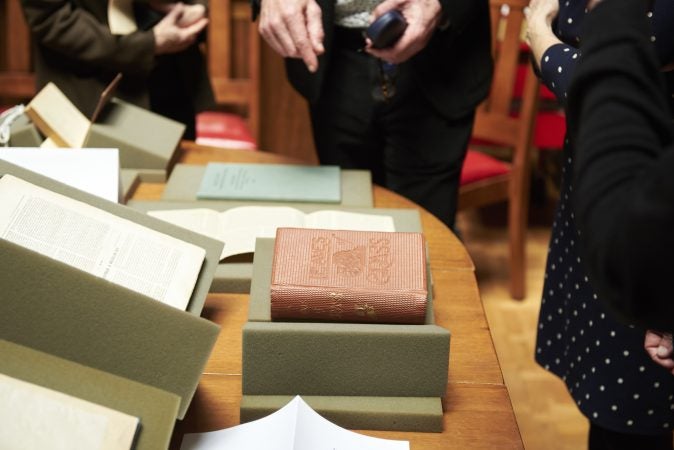Whitman at 200: Penn programming looks at the Good Gray Poet, his legacy across the river
Gearing up for Walt Whitman’s 200th birthday on May 31, Penn’s “Whitman at 200” project hosted a gathering showcasing material from the last 20 years of the writer’s life.

The Whitman at 200 Symposium pop-up exhibition includes photographs of Walt Whitman. (Natalie Piserchio for WHYY)
On the 127th anniversary of Walt Whitman’s burial across the river in Camden, literature academics gathered at the University of Pennsylvania to discuss some finer points of “The Good Gray Poet” and his work.
The symposium, “Whitman at 200: Looking Back, Looking Forward,” was part of a larger, yearlong art and civic-engagement program in collaboration with Penn Libraries called “Whitman at 200: Art and Democracy.” The programming — which ramps up with Whitman’s 200th birthday on May 31 — takes place in both Philadelphia and Camden.
For Judith Tannenbaum, artistic curator of “Whitman at 200,” it was important for the project to be spread across the two cities. It’s partially a nod to Whitman’s famous line, “I contain multitudes.” But it also acknowledges that while Whitman spent much of his life in Philadelphia, after having a stroke he moved to Camden to be closer to his brother, and spent the last 20 years of his life there.
“I was very struck by the relationship of Philadelphia and Camden, how close they are to each other, but how there seems to be this separation,” Tannenbaum said. “I became very interested in that and … bringing the cities closer by the separation of the river.”
Over the next two months, “Whitman at 200” programming will span an array of art worlds, from poetry readings to public art installations. A few of the public art projects will be focused on the Delaware River, including a Cherry Street Pier performance by the Bearded Ladies Cabaret about Whitman as a gay hero, and an installation on the ferry that runs between the two cities.
Along with Saturday’s symposium, a pop-up exhibit teased to a larger exhibit coming to Penn in May — “Whitman Vignettes: Camden and Philadelphia,” which will look at “the poet of democracy” and material from Penn’s Kislak Center for Special Collections, Rare Books and Manuscripts.
The Kislak Center has a number of documents from the last 20 years of Whitman’s life, such as letters showing the poet’s hand at work and different variations on his 1855 “Leaves of Grass” collection, which he revised multiple times before his death.
Saturday’s pop-up exhibit also included material related to the controversial naming of the Walt Whitman Bridge in the late 1950s. At the time, the Diocese of Camden was unhappy with the naming, questioning Whitman’s morality and whether he was worthy of being so honored. It sent mimeographed letters to the Delaware River Port Authority posing questions such as, “In what way has he inspired or influenced American democracy for good?”
“I think a lot of people didn’t know much about him, but they were goaded on by the church in some way,” said Lynne Farrington, the center’s senior curator and “Whitman at 200’s” project director.
A part of celebrating Whitman this year is about not only looking at him in the past, but also looking at his importance to the present and his role in the future, Farrington said.

“We want to think about the role of the political situations at the time of Whitman’s life,” she said. “Not only before the Civil War, but after the Civil War.”
Tannenbaum added that the title “Art and Democracy” is a look at why Whitman’s work is still relevant today, more than 150 years after he wrote pre- and post-Civil War.
She said Whitman’s writing can spawn conversations on just about anything. The fact that, in some lines of his work, he’s very self-aware but also raises contradictions which can raise a point in today’s polarizing political world.
“I think Whitman is one of the writers who has a way of touching on everything, from the small details of everyday life to the big questions,” Tannenbaum said. “At this point in our political lives, it would be wonderful to just be able to have people talk to each other without having that terrible divide and polarization, and I think if we can generate conversations that allow people on different sides of issues to talk to each other that that would be success right there.”
“In no way do we want to blindly just celebrate Whitman, we really want to get under the skin and think about contradictions as well as assurances,” she added. “Hopefully, he would like that.”

Penn has a number of Whitman programs coming up, including a public art project that will culminate in a mobile printing studio that will travel around the Philadelphia region engaging people in 19th-century printmaking and the letterpress.
You can find a list of “Whitman at 200” events here.
WHYY is your source for fact-based, in-depth journalism and information. As a nonprofit organization, we rely on financial support from readers like you. Please give today.






















